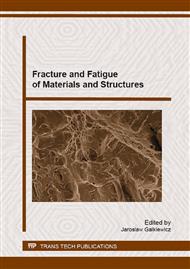p.145
p.151
p.157
p.163
p.169
p.175
p.182
p.191
p.197
Fatigue Life of Welded Joints of High-Strength Structural Steel S960QL
Abstract:
The article presents the results of research on low cycle fatigue strength of welded joints of structural steel S960QL. Two types of butt welds were analysed: I-joints and V-joints. The tests were performed under load controlled using the total strain amplitude εac. Fatigue life analysis was conducted based on the Manson-Coffin-Basquin equation, which made it possible to determine fatigue parameters. High concordance was found of the adopted description model with experimental results. Studies have shown differences in the fatigue life of the various joints analysed, wherein I-joints showed about 20-50% higher fatigue life. Fractographic tests of fatigue fractures in joints revealed the details of fatigue cracking and differences in the propagation rate of fatigue cracks.
Info:
Periodical:
Pages:
169-174
Citation:
Online since:
April 2016
Authors:
Keywords:
Price:
Сopyright:
© 2016 Trans Tech Publications Ltd. All Rights Reserved
Share:
Citation:


